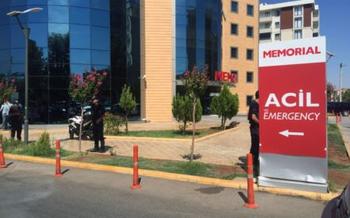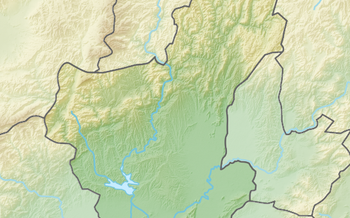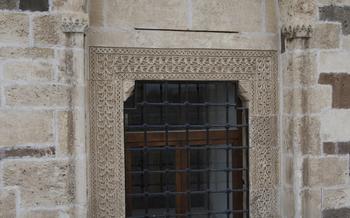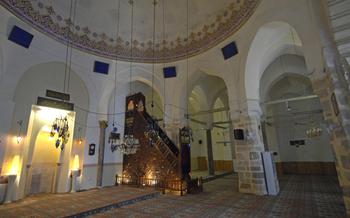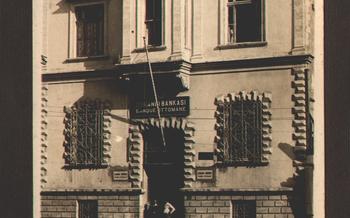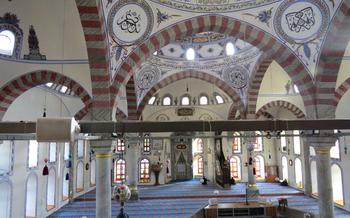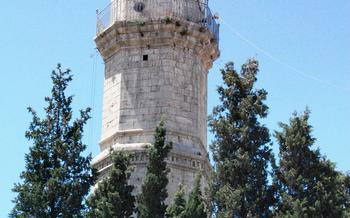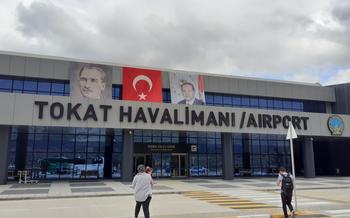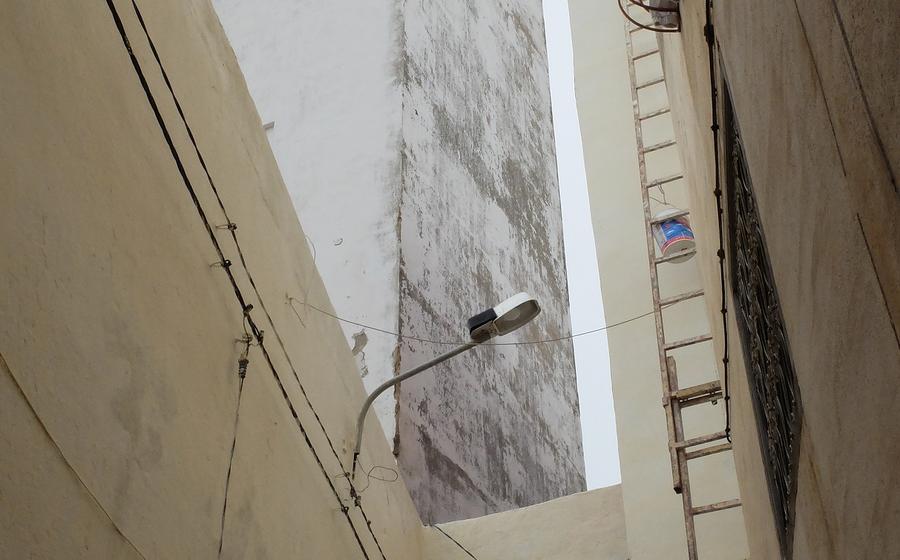
Van Great Mosque (Ulu Camii)
- Van Great Mosque (Ulu Camii): A Historic and Architectural Masterpiece
- Exploring the Enchanting Interiors:
- Immerse in the Spiritual Atmosphere:
- Unveiling the History of Van
- A Symbol of Resilience
- Architectural Highlights
- A Place of Worship and Community
- Exploring the Environs
- Tips for Visitors
- Unforgettable Moments
- The Power of Faith
- Preserving Cultural Heritage
- Beyond the Mosque: Exploring Van's Treasures
- Embracing Cultural Exchange:
- Insider Tip:
Van Great Mosque (Ulu Camii): A Historic and Architectural Masterpiece
In the heart of Van, a city steeped in history and natural beauty, stands the Van Great Mosque, a testament to the region's rich cultural heritage. Built in the 12th century during the Seljuk dynasty, this architectural masterpiece has endured the test of time, becoming a symbol of Van's resilience and faith.
The mosque, also known as Ulu Camii, boasts a unique architectural style that blends Seljuk and Ottoman elements. Its intricate tilework, stunning dome, and soaring minarets are a testament to the craftsmanship of the era. The mosque's courtyard, adorned with a serene fountain, invites visitors to pause and reflect before entering the sacred space.
As a symbol of Van, the Great Mosque holds a special place in the hearts of the local community. It serves as a center of religious devotion, a gathering place for community events, and a symbol of unity and resilience.
I remember my first visit to the Van Great Mosque vividly. As I stepped through the grand entrance, I was struck by the sheer beauty and tranquility of the space. The intricate tilework and calligraphy adorned the walls, while the sunlight filtered through the stained-glass windows, casting a warm glow upon the interior. I felt a sense of reverence and awe as I explored the mosque's many wonders.
Exploring the Enchanting Interiors:
As you step through the grand entrance of the Van Great Mosque, you will be greeted by a mesmerizing courtyard that exudes tranquility. The courtyard, adorned with lush greenery and intricate tilework, serves as a peaceful sanctuary for visitors seeking respite from the bustling city. Take a moment to admire the stunning tilework that adorns the walls of the courtyard, each tile intricately painted with vibrant colors and geometric patterns. The intricate calligraphy that adorns the arches and doorways adds to the mosque's charm and elegance.
Venture further into the mosque and discover the breathtakingly beautiful mihrab, a niche indicating the direction of Mecca. Carved from a single block of marble, the mihrab is a masterpiece of Islamic art, featuring intricate carvings and delicate floral motifs. Its grandeur and artistry are a testament to the skill and devotion of the Seljuk craftsmen who created it.
During my visit to the mosque, I was fortunate enough to witness a congregational prayer. The atmosphere was electrifying, with the melodious voices of the imam and the congregation filling the mosque. As I observed the faithful bowing and prostrating in unison, I couldn't help but feel a sense of awe and reverence for the sacredness of this space.
Immerse in the Spiritual Atmosphere:
As you step through the grand entrance of the Van Great Mosque, a profound sense of serenity envelops you. The mosque's spacious courtyard, bathed in soft natural light filtering through the stained-glass windows, invites you to pause and reflect. The intricate tilework adorning the walls and floor, each tile meticulously crafted and arranged, showcases the artistry and devotion of the mosque's builders. Overhead, the beautifully carved mihrab, the focal point of the mosque, points towards Mecca, reminding worshippers of the spiritual journey they are embarking on.
In this sacred space, you witness the traditional Islamic practices that have been preserved and passed down through generations. Worshippers gather in rows, their heads bowed in humility, their voices rising in unison as they recite verses from the Quran. The rhythmic chanting, accompanied by the gentle sway of bodies, creates a mesmerizing spectacle that transports you to a realm of spirituality and devotion.
During my visit to the mosque, I had the privilege of experiencing the call to prayer (Adhan), a mesmerizing melody that reverberated through the air, beckoning the faithful to come together in worship. As the sun cast a warm glow over the mosque's courtyard, I felt a deep sense of connection with the community and a profound appreciation for the spiritual significance of this sacred space.
Unveiling the History of Van
The Van Great Mosque is deeply intertwined with the history of Van and the Seljuk dynasty. Built during the reign of Sultan Alparslan in the 11th century, the mosque stands as a testament to the Seljuk's architectural prowess and their commitment to preserving Islamic heritage.
Throughout the centuries, the mosque has witnessed numerous historical events, serving as a focal point for religious, social, and political gatherings. It has survived earthquakes, conflicts, and invasions, becoming a symbol of Van's resilience and enduring spirit.
The mosque's rich history is evident in its architecture, which blends Seljuk and Anatolian influences. The intricate tilework, calligraphy, and carvings depict scenes from Islamic history and showcase the artistry of the period.
To delve deeper into the mosque's history, I sought the insights of a local historian, Professor Aylin. She shared fascinating tales about the mosque's role in shaping Van's cultural and religious landscape. From hosting royal ceremonies to providing refuge during times of turmoil, the mosque has played a pivotal role in the city's narrative.
Her stories brought to life the rich tapestry of Van's past, making my visit to the mosque not just a historical exploration but a journey through time.
A Symbol of Resilience
Despite enduring the ravages of earthquakes and conflicts, the Van Great Mosque has emerged as an enduring symbol of the city's resilience. Throughout its existence, the mosque has undergone meticulous restoration efforts and preservation initiatives, ensuring its continued existence as a testament to Van's indomitable spirit.
One of the most inspiring aspects of the mosque's history is its ability to rise from the ashes time and again. Having withstood the devastating earthquake of 1941, which leveled much of Van, the mosque underwent extensive reconstruction, retaining its original architectural grandeur.
Moreover, the mosque has played a pivotal role in preserving Van's cultural heritage. Serving as a repository of Islamic knowledge and traditions, the mosque has fostered a sense of cultural identity among the local population. Through its educational and social initiatives, the mosque has contributed to the preservation and transmission of Van's rich cultural legacy.
I had the privilege of witnessing the mosque's restoration firsthand during my visit to Van. The sight of skilled artisans meticulously repairing the intricate tilework and carvings was a testament to the dedication and commitment of the local community to preserving their cultural heritage. The mosque's resilience, coupled with the unwavering efforts of the community, serves as a beacon of hope and inspiration, demonstrating the enduring power of cultural heritage.
Architectural Highlights
The Van Great Mosque (Ulu Camii) stands as a testament to the architectural brilliance of the Seljuk dynasty. Its unique Seljuk architectural style is evident in every corner of the mosque, from its stunning dome and minarets to its intricate stone carvings and reliefs. The mosque's dome, a symbol of Islamic architecture, is particularly captivating with its intricate patterns and geometric designs. The minarets, towering over the city, offer breathtaking views of Van and the surrounding landscape. As you explore the mosque's exterior, take a moment to admire the exquisite stone carvings and reliefs that adorn the walls, depicting scenes from Islamic history and culture. One such detail that I discovered during my visit was a hidden carving of a mythical griffin, a symbol of strength and power in Seljuk art. This hidden gem added a touch of mystery and wonder to my exploration of the mosque.
A Place of Worship and Community
The Van Great Mosque is not just a historical and architectural marvel; it is also a thriving center of religious devotion and community engagement. As a practicing Muslim, I was particularly moved by the mosque's vibrant spiritual ambiance and the deep sense of community among the worshippers.
During my visit, I witnessed the mosque's central role in the daily lives of Van residents. Devout Muslims from all walks of life gathered here to perform their daily prayers, seeking solace, guidance, and connection with the divine. The mosque's spacious prayer hall, adorned with intricate carpets and soft lighting, created an atmosphere of serenity and tranquility, conducive to contemplation and spiritual reflection.
Beyond its religious significance, the Van Great Mosque also serves as a hub for community activities and social initiatives. The mosque's courtyard and adjacent buildings host various educational programs, workshops, and charitable events throughout the year. These initiatives aim to foster a sense of unity and cooperation among community members, promoting social welfare and addressing the needs of the underprivileged.
My most memorable experience at the mosque was attending a heartwarming community gathering during the holy month of Ramadan. Muslims from across Van came together to break their fast collectively, sharing food, stories, and laughter. It was a beautiful display of unity, compassion, and the power of faith to bring people together.
Exploring the Environs
Beyond the spiritual and architectural significance of the Van Great Mosque, its surroundings offer a vibrant tapestry of history, culture, and local life. Just a short walk from the mosque, you'll find yourself immersed in the bustling neighborhood, a melting pot of diverse ethnicities and traditions. Discover hidden gems like traditional Turkish coffeehouses, artisanal workshops, and family-run restaurants serving mouthwatering local delicacies.
A visit to the nearby Van Castle is a must for history enthusiasts. Perched atop a hill overlooking the city, the castle offers panoramic views that will leave you breathless. Explore its ancient ramparts, marvel at the intricate stone carvings, and learn about its fascinating history as a strategic fortress and royal residence.
For a truly immersive experience, delve into the vibrant Van Bazaar, a labyrinth of stalls and shops selling an array of local handicrafts, carpets, jewelry, and souvenirs. Engage with friendly vendors, haggle for the best prices, and discover unique treasures that reflect the rich cultural heritage of the region.
In my own travels, I had the pleasure of meeting a local artisan named Mehmet, who specializes in hand-woven carpets. As he deftly guided the colorful threads through his loom, he shared stories about his family's centuries-old tradition of carpet making. It was a moment of genuine cultural exchange, where I not only gained a deeper appreciation for Turkish craftsmanship but also formed a lasting connection with a local master.
Tips for Visitors
To ensure a respectful and enriching visit to the Van Great Mosque, here are some essential tips:
-
Dress Code and Behavior: Respectful attire is expected, covering shoulders and knees for both men and women. Maintain a modest and courteous demeanor within the mosque's sacred space.
-
Interacting with Locals: Engage with locals with a warm and friendly attitude. Greetings like "Merhaba" (hello) and "Hoş geldiniz" (welcome) are appreciated. Remember to ask permission before taking photos of people.
-
Photography Guidelines: Photography is generally permitted within the mosque, but avoid using flash or disturbing worshippers during prayer times. Always seek permission before taking photos of individuals.
-
Personal Anecdote: During my visit, I encountered a kind local who noticed my interest in the mosque's architecture. He offered to share his knowledge and showed me a hidden courtyard with stunning views of the city. This unexpected encounter enriched my understanding of the mosque's significance and the warmth of the Van community.
Unforgettable Moments
Amidst the tranquil ambiance of the Van Great Mosque, there are certain moments that leave an enduring mark on the soul. One such experience is witnessing the mesmerizing call to prayer, known as the Adhan. As the muezzin's voice reverberates through the air, a sense of serenity envelops the entire mosque. The melodious chanting, echoing through the centuries-old walls, evokes a deep sense of spirituality and reverence.
During the holy month of Ramadan, the mosque transforms into a hub of devotion and community spirit. The faithful gather for extended prayers, breaking their fast together, and engaging in acts of charity and reflection. The atmosphere during Ramadan is truly magical, filled with a sense of unity and spiritual upliftment.
Throughout the year, the mosque hosts traditional Islamic festivals and celebrations that showcase the vibrant cultural heritage of Van. These events bring together people from all walks of life, creating a tapestry of colors, music, and joyous festivities. Participating in these celebrations offers a unique opportunity to immerse oneself in the rich traditions and customs of the region.
One particularly moving experience I had was during a special night prayer session during Ramadan. As I stood shoulder-to-shoulder with fellow worshippers, I felt a profound sense of connection and unity. The shared prayers, the collective recitation of verses from the Quran, and the palpable sense of spirituality left an indelible mark on my heart.
The Power of Faith
Beyond its architectural splendor, the Van Great Mosque (Ulu Camii) holds profound spiritual significance for the people of Van and the wider Muslim community. As a sacred place of worship, the mosque serves as a testament to the power of faith in Turkish society. Witnessing the devotion of the worshippers, their serene expressions during prayers, and the communal spirit that permeates the mosque's atmosphere is a truly humbling experience.
The mosque's role extends beyond religious practices; it's a hub for community engagement and spiritual guidance. I had the privilege of conversing with a local imam who shared insights into the significance of mosques in Muslim communities. He explained how mosques foster a sense of unity, provide a platform for education and social welfare, and promote the values of peace, compassion, and understanding.
Visiting the Van Great Mosque was not just an architectural exploration; it was a journey into the heart of faith and spirituality. The mosque's majestic presence, coupled with the unwavering devotion of its worshippers, left an indelible mark on my soul, reminding me of the profound impact faith can have on individuals and communities.
Preserving Cultural Heritage
Van Great Mosque stands as a testament to the enduring power of cultural heritage. Its existence serves as a reminder of the importance of safeguarding and promoting Islamic architecture and history. The mosque's preservation efforts are a testament to the community's dedication to protecting their cultural identity.
Initiatives to restore and maintain the mosque have been undertaken by local authorities and organizations. These efforts involve skilled artisans and craftsmen who meticulously work to preserve the mosque's original features. By employing traditional techniques and materials, they ensure that the mosque's architectural integrity remains intact.
The preservation of Van Great Mosque is not just about protecting a building but also about preserving the cultural heritage of Van and Turkey as a whole. The mosque serves as a symbol of the region's rich history and cultural diversity. By preserving it, the community ensures that future generations can continue to appreciate and learn from this architectural masterpiece.
Personal Anecdote:
During my visit to Van, I had the opportunity to witness firsthand the restoration work being carried out on the mosque. I was amazed by the level of dedication and craftsmanship exhibited by the artisans involved in the project. They carefully restored intricate tilework, repaired damaged stone carvings, and ensured that the mosque retained its original splendor.
Their work was not just about preserving a building but also about preserving a piece of Turkish history. Through their efforts, the mosque will continue to stand as a symbol of Van's cultural heritage for generations to come.
Beyond the Mosque: Exploring Van's Treasures
Van offers a wealth of historical and cultural attractions beyond the Van Great Mosque. Embark on a journey to discover the ancient Van Castle, perched atop a hill and offering panoramic views of the city and Lake Van. Explore the ruins of the medieval Armenian Kingdom of Cilicia, including the impressive fortress of Van and the historic churches of Akdamar Island. Immerse yourself in the vibrant Van Museum, showcasing the region's rich archaeological and ethnographic heritage.
For a taste of local flavors, venture into the bustling Van Bazaar, a shopper's paradise filled with colorful stalls selling traditional handicrafts, carpets, and local delicacies. Indulge in the culinary delights of Van, renowned for its delicious kebab, grilled to perfection and served with fresh vegetables and aromatic herbs.
Nature enthusiasts will find solace in the breathtaking landscapes surrounding Van. Explore the pristine shores of Lake Van, the largest soda lake in the world, and marvel at the unique flora and fauna that call this region home. Hike through the scenic Mount Suphan Nature Reserve, offering stunning views of the surrounding mountains and valleys.
Embracing Cultural Exchange:
The Van Great Mosque is not just a religious site; it's a place where cultures converge and exchange. Engage with the friendly locals, who are eager to share their way of life and stories. Share your own cultural experiences and traditions, fostering a sense of global understanding and friendship. I recall a memorable encounter with a group of Turkish students who were intrigued by my Western background. We exchanged stories, laughed together, and left with a newfound appreciation for each other's cultures. Embrace this opportunity for meaningful cross-cultural exchange, leaving a lasting impact on both yourself and the local community.
Insider Tip:
To fully appreciate the tranquility and beauty of the Van Great Mosque, consider visiting during the early morning or evening hours when the crowds are fewer. This will allow you to immerse yourself in the serene atmosphere and take your time exploring the mosque's intricate details.
For a deeper understanding of the mosque's history and significance, I highly recommend seeking guidance from a local guide. They can provide valuable insights into the mosque's architectural features, religious significance, and its role in Van's cultural heritage.
To make your visit even more enriching, combine it with a stroll through the vibrant Van Bazaar, located just a short walk away. This bustling marketplace offers a glimpse into the local culture and is a great place to find unique souvenirs and handicrafts. As you wander through the narrow streets, be sure to engage with the friendly locals and learn about their way of life.
I recall an unforgettable moment during my visit to the mosque. As I stood in the courtyard, admiring the stunning sunset view, I felt a profound sense of peace and tranquility. The golden hues of the sky illuminated the mosque's majestic dome and minarets, creating a breathtaking spectacle. It was a moment that reminded me of the beauty of cultural heritage and the importance of preserving historical landmarks for future generations.
